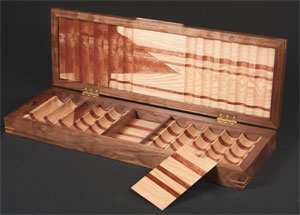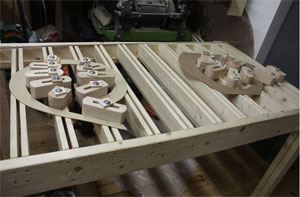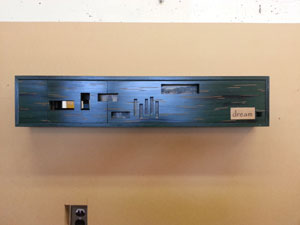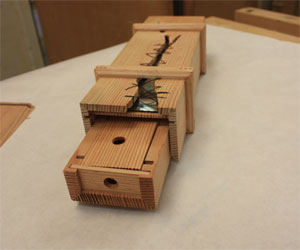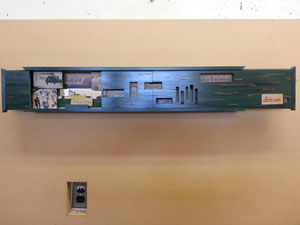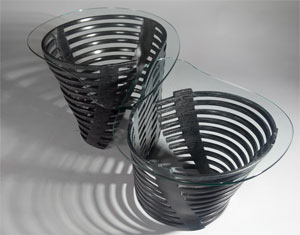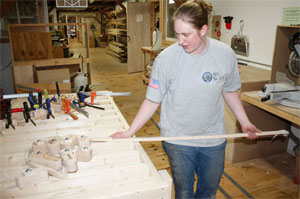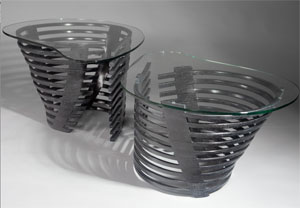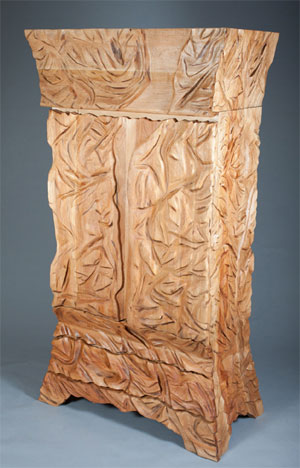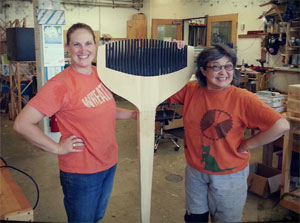
While Alicia Dietz was spending her 10 years in the army, doing the flying and traveling that she loved, she was also taking advantage of the woodshops that were set up at each base.
“There was always someone there so it was safe, and you could go and experiment. I did it at every base I was at,” Alicia said.
photo by Amanda Lass
After a while, however, she started getting an itch to do something more creative on a more permanent basis, and transitioned out of the army — and into woodworking school.
Now enrolled at the Vermont Woodworking School in the northern part of that state, “Mostly, I’ve used school as an experiment,” she said. “I’m trying everything I possibly can.”
Often, Alicia said, she finds herself working in the area of expertise of whichever instructor she’s currently studying with. At the school, those instructors have included Brian Bright, Mario Messina, Sam Norris, Dave Hurwitz and the late Bob Fletcher — and she has also taken advantage of internship-type opportunities with woodworkers like Wendy Maruyama and Garrett Hack.
Required by the school to have an internship, “I really wanted to have an internship with a female woodworker,” Alicia said. Citing both her Army pilot days and her current involvement in woodworking, she said, “I appreciate a woman’s perspective in a male-dominated field.”
After contacting Maruyama, with her decades of experience in woodworking, the two worked out an internship arrangement and, said Alicia, “It was amazing. It was a transformative experience.” Much of the internship, she said, focused on the idea of concept, of how to arrive at a piece. “I wrote a lot of journal entries, some of them very personal, and had weekly assignments that would morph into a piece at the end of the week.”
She would also explore questions like “Do I want to send a message? Or do I want to make a straight-up table?” with a piece, a perspective she’s brought back to her last semester at the Vermont Woodworking School.
At school, where Alicia is enrolled in a two-year advanced certificate program for woodworking, she said she has gained much technical experience — a particular asset after her previous experiences.
“At the shops in the military, they’re mostly concerned with safety, that you didn’t cut off your finger. I didn’t even know about wood movement before I came to school,” she said. The first piece she built, for instance, was a coffee table, inspired by an interesting map she had acquired in Italy. She wanted the coffee table to showcase the map underneath its glass top.
The coffee table, however, was built from maple and walnut and, “I didn’t know anything about wood movement, so it has cracked and moved. I’ll have to resource that map.”
photo by Amanda Lass
Recently, Alicia built a different coffee table. This one, entitled “Thru the Looking-Glass,” is currently featured in a New Hampshire Furniture Masters’ show, “Mentoring Makers.” [Editor’s Note: the show is on exhibit at the New Hampshire Furniture Masters Association gallery in Concord until Nov. 12, 2013.]
It’s a show comprised of pieces from nine young furniture makers who travelled to Garret Hack’s shop in southern Vermont once a month. “We were all working on different projects, and we’d brainstorm techniques and design,” Alicia said. “It was a good mix of experience levels and approach.”
Alicia’s piece, she said, was part of this internship-like program, as well as a class at school with Mario Messina, who frequently uses the bent lamination technique. “It was a different technique than I’d used before, and I really enjoyed it,” she said. Each of her stacks of laminates is made up of nine laminations apiece, and each has a different arc, which meant she had to be able to change the bending form.
photo by Amanda Lass
“The coffee table has a lot of nice form to it, but it’s also extremely functional. Whoever owns it can take it apart and reconfigure it. They can put it in whatever orientation they want.”
Many of the pieces she’s built while in Vermont have been made of maple, Alicia said, due to its abundance in the area. However, “I will not build a mountain dresser out of maple again, because it’s so heavy!” she noted.
Still, the “High One Mountain Dresser” is a favorite of her pieces. “I made it for a friend who climbed Mount Denali in Alaska, and it looks like a rock face,” she said. “The front of the doors is actually a topographical map of Denali, and between the base and the bottom door is the skyline of the Alaskan range.”
photo by Amanda Lass
It also incorporates carving, another of Alicia’s favorite aspects of woodworking. “Whether it’s with a gouge or an angle grinder, I really enjoy the shaping of wood,” she said.
“I’m drawn to form and function working together,” Alicia said, “and I’d also like to give a shoutout to my military background. It’s given me the discipline to follow through on a lot of things, which is a huge advantage for what I hope to be a career in woodworking.”
